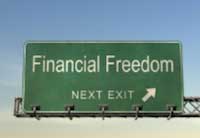Debt-Free in 2013: Three Ways to Do It and Three Reasons You Should
 Want to get rid of the credit card debt you’ve racked up in 2013? Becoming debt-free is a noble quest and a worthy resolution. We’ll give you three strategies for doing so, and three good reasons to stick with your plan should your will begin to flag.
Want to get rid of the credit card debt you’ve racked up in 2013? Becoming debt-free is a noble quest and a worthy resolution. We’ll give you three strategies for doing so, and three good reasons to stick with your plan should your will begin to flag.Three ways to cut down on your credit card debt
Consider a balance transfer credit card. A balance transfer credit card allows you to shift your debts from your other credit cards and pay them down interest-free for an introductory period. The industry leaders currently give you 18 months to avoid interest payments. However, keep in mind that there is an upfront fee – usually 3% – assessed on the amount that you transfer. Make sure that the savings on interest will outweigh the balance transfer fee. Check out our picks for the top balance transfer credit cards if you do end up transferring your balance.Know thyself. Dave Ramsey advocates paying off your debts in order of the smallest amount of debt to the highest. The feeling of achievement you get from paying off a debt completely will give you the boost to pay off the others – the debt snowball. However, the mathematically prudent way to pay off your debts is to do so in order of highest interest rate to lowest, to minimize the total amount paid. If you can stick to a debt repayment plan without that psychological boost, you’ll be able to save a hefty chunk of change.
Pace your purchases. Set budgets for the essentials – groceries, rent or mortgage payments, etc. – and stick to them. Beyond that, how should you deal with discretionary purchases like clothes or a new phone? Take a weeklong “cooling-off” period. If you still want those shoes or tickets after a week, and you’ve rationally decided that you can still afford it while paying down your existing debts, go for it. The trick is to avoid impulse buys by not making decisions in the heat of the moment.
Three reasons to cut down on your credit card debt
Americans are drowning in debt. The average household credit card stands at $15,418 – that’s even more than last year. If you include other types of debt, like mortgages and student loans, the picture is even grimmer. Collectively, American consumers owe $2.75 trillion. Don’t become a statistic.The minimum payment isn’t enough. Let’s say you’re the average American with $15,418 owed. You make your minimum monthly payment – an estimated $309 – and you’ll be paying off your debt for 31 years. In that time, you’ll pay over $18,000 in interest – more than your original balance! It’s not enough to do what’s on your credit card statement. You need a plan to get debt-free.
Credit card debt can keep you from getting other loans. If you’re using most of your available line of credit, it will reflect poorly on your credit score. Your debt utilization ratio – the amount of money you owe compared to how much you’re allowed to value – is a major factor in your FICO score. If you have a high ratio, you might be charged higher interest rates or be denied altogether.
We wish you the best in getting debt-free in 2013!

No comments:
Post a Comment